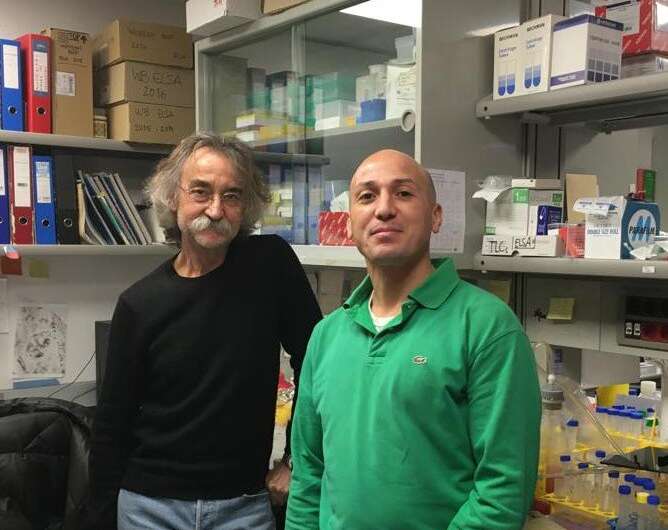Molecular mechanism involved in the cholesterol cell transport

A team of the University of Barcelona (UB) and the August Pi i Sunyer Biomedical Research Institute (IDIBAPS) identified a mechanism involved in the movement of cholesterol inside the cells. The study, published in the Journal of Cell Biology, shows how the SNX13 protein plays a key role when transporting this lipid outside the liposomes, organelles that conduct cellular digestion. These results could have implications in the future developing treatments against pathologies caused by dysfunctions in the intracellular cholesterol transport, such as the Niemann-Pick type C1 disease.
The study counts on the participation of lecturers from the Faculty of Medicine and Health Sciences of the UB and the CELLEX Biomedical Research Centre (IDIBAPS-UB) Albert Lu, first author of the article, and Carles Enrich, together with researchers from Stanford University.
The harmful effects of unbalanced cholesterol levels
Most part of the cholesterol that cells use comes from the outside, reaching the lysosomes where it is distributed to different intracell compartments. However, there are still unsolved questions related to the precise molecular events that regulate the exit of cholesterol from this organelle and its transport towards the membrane and the cell endoplasmic reticulum. The objective of this study has been to study the mechanism thanks to which cholesterol exists the lysosomes. "This process requires the coordinate action of NPC1 and NPC2 transporters that, together with the bis(monoaclyglycero)phosphate (BMP) lysosomal lipid, mobilize and export the free cholesterol," notes Carles Enrich.
The regulation of the intracellular trafficking of cholesterol and the quantity the cellular organelles receive is important for the balance—or homeostasis—of cholesterol in the cell. Errors or dysfunctions in its transport cause an imbalance that causes disorders such as Niemann-Pick type C disease. This pathology, which has no current cure, is produced by mutations in the lysosomal cholesterol transporters NPC1 and NPC2. This disease prevents cholesterol and other fats from being metabolized normally and has serious effects on the liver, spleen and the brain.
Genome-wide CRISPR/Cas9-type genetic screening
In order to identify the regulators of cholesterol balance, researchers conducted CRISPR/Cas9-type genetic screenings in the genome. This methodology allows an interrogation in a massive and parallel manner, of the human genome regarding a specific biological process, generating a great amount of data. In this study, the screening was applied under normal conditions, but also blocking the NPC1 protein in order to identify cell elements that can export cholesterol parallelly to this transporter.
This strategy enabled the identification of genes that, when removed, alter the intracellular cholesterol or BMP levels. "Our genetic screenings identified a high number of genes involved in the cholesterol and BMP metabolic regulation, whose role was unknown to date. In addition, we confirmed a tight correlation and regulation between the levels of these lipids," notes Albert Lu.
One of the involved molecules in this process is that SNX13, a protein in the endoplasmic reticulum that negatively regulates the exit of cholesterol from lysosomes to the plasmatic membrane, thus reducing the amount of this lypid. "Given the lack of the function of NPC1, the reduction of SNX13 caused a redistribution of lysosomal cholesterol towards the plasmatic membrane, which indicates that SNX13 could be an important regulator in this cholesterol transport pathway," says Albert Lu.
An unexpected view of regulation mechanisms
These results provide with an unexpected view of the regulation of these lipids, since there are a few alternative mechanisms—and most of them are unknown—that allow cholesterol to exit when the NPC1 transporter is inhibited or muted. "We described an alternative pathway regulated by anexin-A6, and with this new study we provide new evidence showing that there can be alternative exit routes for the lysosomal cholesterol parallelly to the NPC1," highlights Carles Enrich.
The finding of molecules able to reverse the effects caused by the NPC1 dysfunction, such as SNX13, could involve the existence of "future therapeutic targets in the treatment of Niemann-Pick type C disease, since a better knowledge of the molecules that take part in the contact between organelles can allow the manipulation of the transport of lipids and ions and re-establish the cellular homeostasis," conclude the researchers.
More information: Albert Lu et al, CRISPR screens for lipid regulators reveal a role for ER-bound SNX13 in lysosomal cholesterol export, Journal of Cell Biology (2021). DOI: 10.1083/jcb.202105060
Journal information: Journal of Cell Biology
Provided by University of Barcelona




















